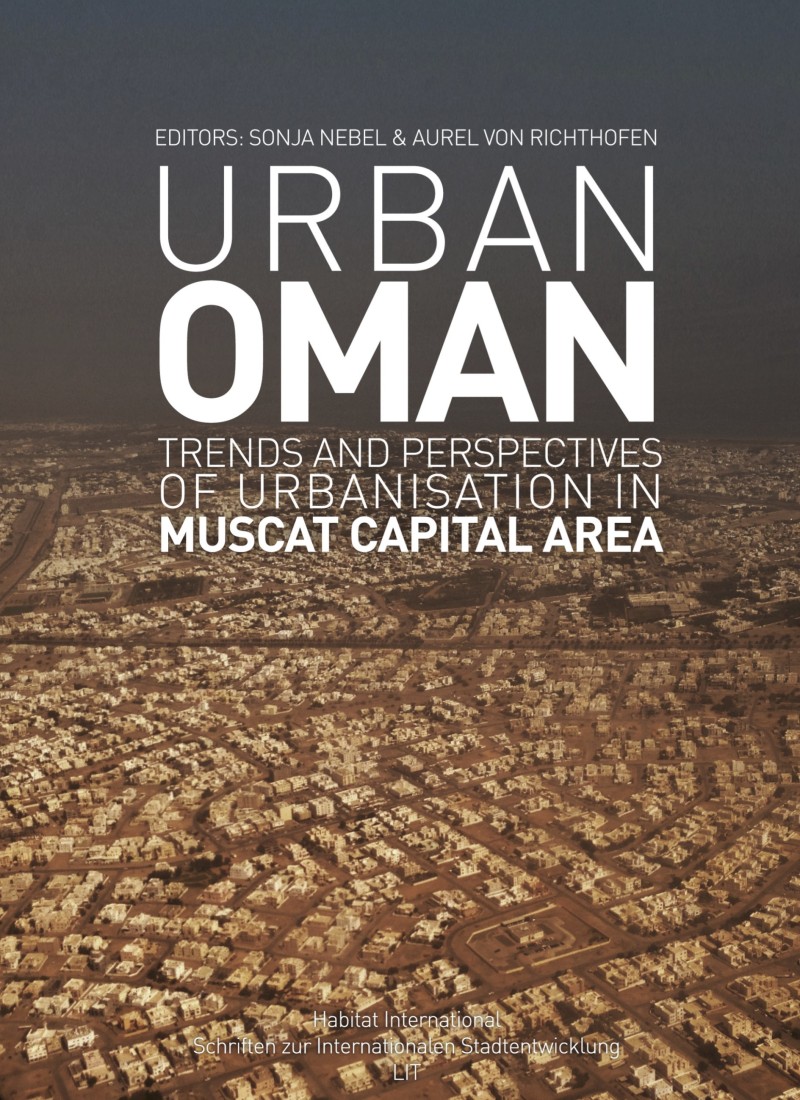The book (2016) Urban Oman – Trends and Perspectives of Urbanisation in Muscat Capital Area edited by Dr. Sonja Nebel and Aurel von Richthofen in the series HABITAT – INTERNATIONAL: Schriften zur internationalen Stadtentwicklung
Vol. 21 can be purchased at LIT Verlag Berlin.
The book traces urbanisation patterns in Oman looking at the coastal strip of Muscat Capital Area. This metropolitan region emerged within the last 50 years almost out of nowhere and is now home of the majority of the national and expatriate population of Oman.
Urbanisation, and the socio-political, economic and environmental aspects attached to it, become an index of the radical spatial transformation of the Sultanate.
This process, if managed well, also holds the key to sustainable urban development. Urban Oman invites geographers, planners, urban designers, architects, decision-makers and scholars of Gulf Studies to rethink the emergence of Muscat Capital Area and to embrace the urban Oman.
From the Editorial
The research covers a time frame of 45 years, starting in 1970, and looks at the era being shaped by Sultan Qaboos bin Said al Said. However, there is a clear focus on the period between 2008 and 2014 to grasp the dynamics and current changes which were taking place while the research was undertaken. This called for a flexible and adaptive methodological approach. Certain shortcomings have been accepted in the quantitative data available, that would not however influence the final qualitative outcome. Thus findings are based to a considerable extent on empirical data collection within two case study areas.
PART 1 looks briefly back at the past 45 years (1970-2015) of urban development in Oman and in particular in Muscat Capital Area. Sonja Nebel and Aurel von Richthofen analyse the background and driving forces of the urbanisation process in Oman and give an overview on physical growth patterns in Muscat Capital Area. Three decisive factors shaping urbanisation are presented in more detail.
Marike Bontenbal discusses population growth and demographic transition and their impact on urbanisation in Oman. Population dynamics as one of the drivers of urbanisation in the country are analysed by presenting an overview of major population trends, including natural population increase, international migration and rural-urban migration – that have all been important forces influencing urban growth in Oman. Underlying economic, social and cultural factors are also discussed that have led to demographic change.
Claudia Kruschwitz focuses on the road network throughout the country and in Muscat Capital Area. A brief insight into 45 years of priority given to the expansion and improvement of car-based transportation infrastructure helps understanding the urban structure that has emerged over time. She points out how the development of the Capital Area brought about a new economic basis, with new employment sectors and a new car-dependent lifestyle.
Hamad Al Gharibi explores current lifestyle patterns in Muscat Capital Area promoted by the transformation from the agro/fishing-based economy to the oil-based economy, accompanied by remarkable changes in social and urban structures. This chapter intends to visualise the transformation of socioeconomic conditions and their impact on current urban patterns. It attempts to focus on the negative aspects that might be expected if the current urban management model remains unchanged while the country moves toward the post-oil age. Nowadays lifestyle patterns of the dispersed nucleo families favour the freestanding single villa on a walled plot, and car-based mobility patterns, which both support a high consumption of limited resources.
PART 2 presents the current patterns of urban development in Oman based on two field studies carried out in an area of urban expansion in Muscat Capital Area and in an area of rural-to-urban transformation. Two case studies in Al Khoud and in Fanja have been selected as representative within the Muscat Capital Area and within the context of rural-urban interface.
Aurel von Richthofen presents the patterns of urban expansion that are characteristic in Muscat Capital Area. Through systematic observation and mapping over a period of 4-5 years, a typical development process of a new residential area has been documented. The predominant patterns of urban sprawl are described and impacts are analysed.
In a second chapter Aurel von Richthofen presents quantifiable parameters of urban expansion for the Al Khoud case study. This list is far from complete, but aims to present a ‘tool-box’ for research and a future sustainability model. Starting from measurable lengths and areas, ratios and densities, parameters are discussed that have long served to benchmark land use and infrastructure efficiency in urban developments.
Sonja Nebel describes the characteristic patterns of rural-to-urban transformation in Oman since 1970. The case study of Fanja shows characteristics of physical changes accompanied by social and economic transformation, shaping phases from compact oasis settlements to urbanized sprawl areas.
Anne Eaton and Sonja Nebel review the transformation of house-typologies in the case study of Fanja. Until today Fanja shows the characteristic mixture of old and new buildings, and thus allows to draw a picture of changing house types, building techniques and use of material throughout the past four decades of development. The chapter reveals a clear trend of transformation in line with comprehensive societal changes and economic development. Construction techniques and the use of building materials, patterns and use of open space, and road networks have changed dramatically over four decades. Both the inhabitants of urban areas and of urbanizing rural areas are practicing nearly the same life-style patterns, to be perpetuated by a high, ill reflected consumption of limited resources.
Sara Abdelaal describes the emerging rural-urban interface, analysing interactions between rural and urban on different levels (household, local, national and international), influenced by different factors (political, institutional, social, economic and spatial). These forms of rural-urban interface are characterized by dynamic flows of people, money, goods, resources, information etc.. The prominent relation between the rural and urban in the Arab Gulf Region is changing continuously, and is mainly characterised by dependent relations of under-developed rural areas towards rapidly growing urban centres.
